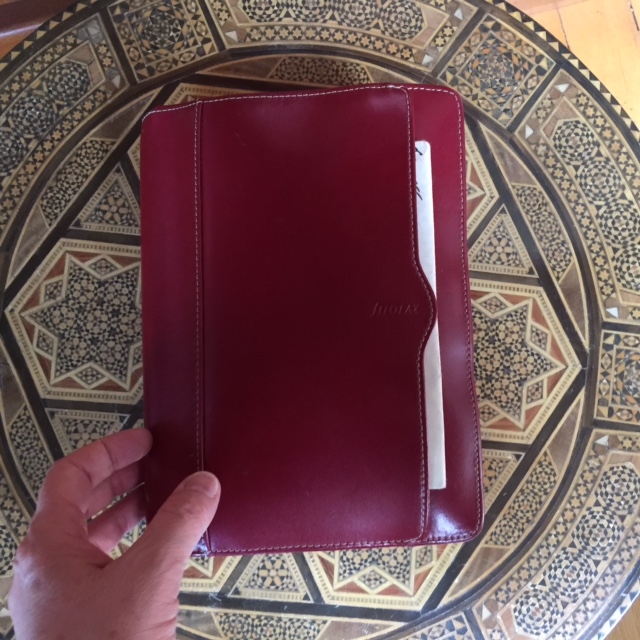 Why
a paper-based organizing system
in this digital age? First, as Get
Things Done guru David Allen puts it, “low-tech
is oftentimes better because it is in your face.” Second,
last I checked (channeling Jaron
Lanier here), I am not a gadget. I cherish the tools that
help me stay organized, yet allow me to abide within generous
swaths of Internet-free time—formally known as normal life
(you know, when you didn't see everyone doing the thumb-twiddling
zombie shuffle). The Filofax personal organizer is one of them.
Why
a paper-based organizing system
in this digital age? First, as Get
Things Done guru David Allen puts it, “low-tech
is oftentimes better because it is in your face.” Second,
last I checked (channeling Jaron
Lanier here), I am not a gadget. I cherish the tools that
help me stay organized, yet allow me to abide within generous
swaths of Internet-free time—formally known as normal life
(you know, when you didn't see everyone doing the thumb-twiddling
zombie shuffle). The Filofax personal organizer is one of them.
 (Note: I have no connection whatsoever
with this company except as a delighted customer.)
(Note: I have no connection whatsoever
with this company except as a delighted customer.)
I got my first Filofax over
25 years ago and it has been a love story ever since. Part of this English company’s
century-old line of organizers originally developed for engineers,
it is a beautifully made 6-ring loose leaf binder. With the Filofax
diary, address book, paper inserts and other items that get tucked
in there, for most users, it fattens up to the size of a paperback
edition of Anna Karenina. Or, say, a Philadelphia cheesesteak
sandwich. Right, it does not fit in a coat pocket.
Depending on the model, the Filofax personal organizer comes
with an assortment of pockets on both the inside and outside
flaps. Mine also includes a pen holder on the right and a highlighter
holder on the left, and it closes securely, so no loose items
(such as that drycleaner’s ticket) can fall out.
Filofax sells a cornucopia of inserts for the 6 ring binder,
from a wide variety of configurations for the diary refill, to
a personal ruler/ page marker, maps of most major cities, a pad
for assorted sticky notes, checkbook holder, business card holder,
super-thin calculator, extra paper in a rainbow of colors, index
tabs, a portable hole punch, and an address book, among other
items.
Countless are the ways to configure
one’s Filofax personal organizer. I’ve evolved into
using the Week on Two Pages diary for noting appointments, birthdays,
and any time-sensitive to-dos; two rulers/ page markers; the
assorted sticky notes pad (though now with my own, more economical,
Post-Its); the address book at the back; plus a “page”
of plastic sleeves for business cards. I stash items such as
stamps and paperclips in the front inner pocket (especially handy
when traveling). Tickets (drycleaners, concerts) go in another
pocket. In addition, I made up several tabbed sections to index
my personal, financial, business, and other to do / might one
day do lists, to which I slap on ideas scribbled on Post-Its
as they occur to me. The tabbed sections follow my personal interpretation
of David Allen’s Get Things Done (GTD) system—his basic
idea being, capture all your to dos in one “bucket”
you regularly revisit, and thereby can clear your mind for more
clarity and creativity in the present moment. (To track more
complex medium and long-term projects, I use the Projecteze
system of a Word.doc table which relies on the sorting feature—that’s
another post.)
As for address book, it’s not my main nor my only address
book, just the addresses I like to keep handy in this particular
system—so, in part, it serves as a paper backup for the
most vital addresses, and those I regularly consult when making
appointments or sending birthday cards and such.
Usually the Filofax stays open on my desk— which works for
me, but clearly that won’t be ideal for those who work in
less private and/or mobile situations. I take it with me when
I travel or attend meetings where I might need to review my schedule
or consult the to do lists and/or address book.
High-end stationary, luggage, and department stores often carry
the Filofax line of organizers and inserts—as does amazon.com—
but to ensure that I get exactly what I want when I want it,
I order the refill for the following year from the Filofax
USA’s on-line shop on September 1st. At year’s
end—following the advice of my tax accountant who says it
could be handy in case of an audit—I file the diary with
the rest of that year’s tax documents.
There are four major disadvantages to this system. None
of them torpedo it for me, but they might for you:



 (Note: I have no connection whatsoever
with this company except as a delighted customer.)
(Note: I have no connection whatsoever
with this company except as a delighted customer.)